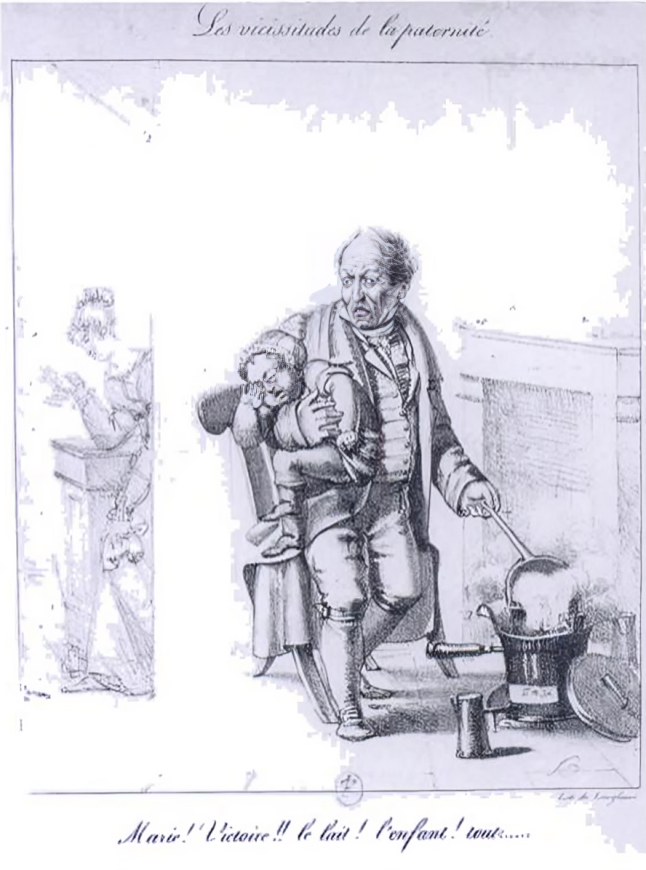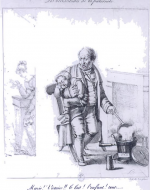Created by Kaitlynn Wolffe on Wed, 10/16/2024 - 09:11
Description:
Depicted above, a father is shown struggling to take care of the multiple tasks of the household. He turns to his wife, but she is unresponsive. In the Regency era, the man and woman in the picture have their positions swapped. This political cartoon served to strengthen current and combat any changes to the strict gender roles that were emerging in the 19th century. In the Regency era, marriage and courtship were fundamentally shaped by strict gender roles that imposed significant constraints on both men and women. These roles dictated behavior, aspirations, and social interactions, creating a rigid framework that affected personal relationships and societal dynamics.
For women, the expectations were especially confining. Society viewed women as primarily mothers and wives, and their worth was directly tied to their ability to marry well and care for the household. The ideal woman was characterized by virtues such as modesty, obedience, and domesticity. Education for women was largely centered on accomplishments that would make them appealing to suitors, such as sewing, cooking, music, and drawing. They were discouraged from intellectual pursuits and were expected to remain in the household as warm and caring mothers and wives. Men, too, faced their own difficulties and expectations, albeit of a different nature. The ideal man was expected to be strong, assertive, and financially stable. He bore the responsibility of providing for a family, and his social standing was often determined by his profession and wealth. Emotional vulnerability was frowned upon; instead, men were expected to exhibit self-control and decisiveness, navigating the complex social politics of courtship with skill and strategy.
These gender roles led to an inherent power imbalance in relationships. Scientific and medical changes led to a strong separation of the sexes called the Split Spheres, or Two Bodies, theory, that pushed the beliefs of differences in strength, intelligence, and place in society. (McEwan 215). Within courtship, men had the upper hand, often initiating contact and determining the pace of the relationship. Women, bound by societal norms, had to rely on indirect signals and subtlety to express interest, creating a dynamic where their voices were often marginalized. The stakes were high; although they had the power to refuse advances or marriage, this is where their powers often ended, and a woman’s reputation could be irrevocably damaged by any perceived impropriety. Meanwhile, a man could more easily navigate social faux pas without significant repercussions.
Although this period is characterized by its constricting gender roles, by the late 19th century, the Romantic movement, which emphasized individual feelings and desires, would begin to push against these strict norms, inspiring some women to seek greater autonomy in their romantic lives. Even before this, Jane Austen captured the tension between societal expectations and personal aspirations in her novels, illustrating the struggles of her characters to assert their identities within the confines of rigid gender roles.
Works Cited
“Marie! Victoire!! The milk! The baby! Everything…,” Les Vicissitudes de la paternité, 1824. Lithograph. Bibliothéque nationale de France, Paris. (Marie! Victoire!! Le lait! L’enfant! Tout…”)
Mainardi, Patricia. “Husbands, Wives and Lovers: Marriage and Its Discontents in Nineteenth-Century France.” AbeBooks, Yale University Press, 1 Jan. 1970, www.abebooks.com/9780300101041/Husbands-Wives-Lovers-Marriage-Discontent....
Mainardi, Patricia. “Husbands, Wives and Lovers: Marriage and Its Discontents in Nineteenth-Century France.” AbeBooks, Yale University Press, 1 Jan. 1970, www.abebooks.com/9780300101041/Husbands-Wives-Lovers-Marriage-Discontent....
McEwan, Cheryl. “Gender, Science and Physical Geography in Nineteenth-Century Britain.” Area, vol. 30, no. 3, 1998, pp. 215–23. JSTOR, http://www.jstor.org/stable/20003898. Accessed 16 Oct. 2024.
Copyright:
Associated Place(s)
Part of Group:
Artist:
- Les Vicissitudes de la Paternité


